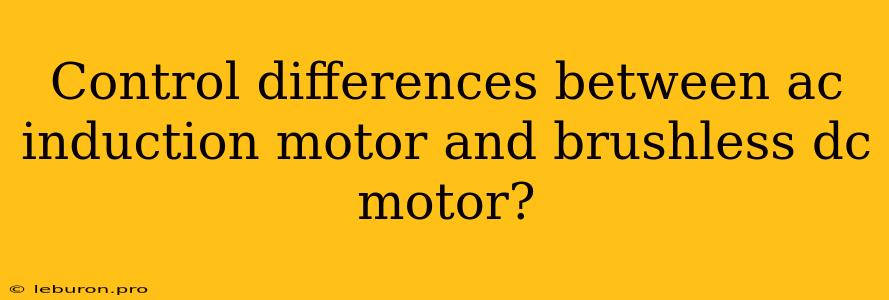Control Differences Between AC Induction Motors and Brushless DC Motors
The choice between an AC induction motor and a brushless DC motor often hinges on the control mechanisms required for the application. Both motor types offer distinct advantages and drawbacks in terms of controllability, making them suitable for different applications. This article will delve into the key control differences between these two motor types, highlighting the factors that influence their performance and application suitability.
AC Induction Motor Control
AC Induction Motor Basics
AC induction motors, also known as asynchronous motors, are the most common type of electric motor found in industrial applications. Their operation relies on the principle of electromagnetic induction, where a rotating magnetic field is generated in the stator, inducing a current in the rotor and creating a torque.
Control Methods
- Voltage Control: The simplest method is to control the motor speed by varying the applied voltage. This method is usually employed for low-power applications where precise speed control is not critical.
- Frequency Control: By adjusting the frequency of the AC power supply, the speed of the motor can be precisely controlled. This is the most common method for controlling AC induction motors in industrial applications. Frequency control is achieved through Variable Frequency Drives (VFDs).
- Slip Control: Slip refers to the difference in speed between the stator field and the rotor. By controlling slip, one can adjust the motor's torque. This method is often employed in high-torque applications.
Advantages of AC Induction Motor Control
- Simplicity: The basic design and control methods make AC induction motors relatively inexpensive and straightforward to implement.
- Robustness: They can withstand harsh environmental conditions and have a high level of mechanical durability.
- Reliability: AC induction motors are known for their long operating life and require minimal maintenance.
Disadvantages of AC Induction Motor Control
- Limited Speed Control: Direct speed control is not as precise as that of brushless DC motors.
- Complex Frequency Control: Implementing frequency control requires specialized VFDs, adding to the overall system complexity.
- Limited Torque at Low Speeds: The torque produced by an AC induction motor decreases significantly at low speeds.
Brushless DC Motor Control
Brushless DC Motor Basics
Brushless DC motors, also known as electronically commutated motors (ECMs), use permanent magnets in the rotor and electronically controlled coils in the stator. The electronic commutation eliminates the need for brushes, resulting in higher efficiency and longer lifespan.
Control Methods
- Pulse Width Modulation (PWM): By rapidly switching the current to the stator coils, a variable voltage is generated, allowing precise speed and torque control.
- Hall Effect Sensors: These sensors provide information about the rotor position, enabling precise control of the switching sequence for smooth operation.
- Back EMF Sensing: This method uses the back electromotive force (EMF) generated by the motor to estimate its speed.
Advantages of Brushless DC Motor Control
- Precise Speed Control: Brushless DC motors offer highly accurate speed control over a wide range.
- High Efficiency: The absence of brushes reduces friction and power losses, resulting in higher efficiency.
- High Torque at Low Speeds: They deliver high torque even at low speeds, making them suitable for applications requiring precise positioning and high starting torque.
Disadvantages of Brushless DC Motor Control
- Complexity: The control electronics required for brushless DC motors are more complex than those for AC induction motors.
- Higher Cost: Due to their more sophisticated design and control circuitry, brushless DC motors are generally more expensive than AC induction motors.
- Susceptibility to EMI: The electronic commutation system can generate electromagnetic interference (EMI).
Choosing the Right Motor
The choice between an AC induction motor and a brushless DC motor depends on the specific application requirements. Here's a breakdown of key factors:
AC Induction Motor:
- Ideal for: High-power applications, heavy-duty industrial machinery, pumps, and fans.
- Advantages: Robust, reliable, and cost-effective.
- Disadvantages: Limited speed control, complex frequency control, lower torque at low speeds.
Brushless DC Motor:
- Ideal for: Applications requiring precise speed control, high efficiency, and high torque at low speeds.
- Advantages: High efficiency, precise speed control, high torque at low speeds.
- Disadvantages: More complex, higher cost, susceptible to EMI.
Conclusion
The control differences between AC induction and brushless DC motors are significant and influence their suitability for various applications. AC induction motors are well-suited for simple, high-power applications, while brushless DC motors excel in applications demanding precise speed control, high efficiency, and high torque at low speeds. By understanding the control characteristics of each motor type, designers can make informed decisions to optimize system performance and efficiency.
